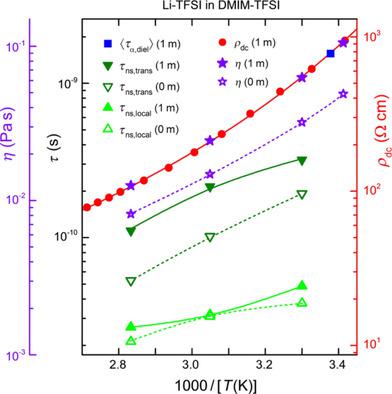当前位置:
X-MOL 学术
›
ChemSusChem
›
论文详情
Our official English website, www.x-mol.net, welcomes your
feedback! (Note: you will need to create a separate account there.)
Ion Dynamics in Ionic‐Liquid‐Based Li‐Ion Electrolytes Investigated by Neutron Scattering and Dielectric Spectroscopy
ChemSusChem ( IF 7.5 ) Pub Date : 2018-09-06 , DOI: 10.1002/cssc.201801321 Charl J. Jafta 1 , Craig Bridges 1 , Leon Haupt 2 , Changwoo Do 3 , Pit Sippel 2 , Malcolm J. Cochran 3 , Stephan Krohns 2 , Michael Ohl 4 , Alois Loidl 2 , Eugene Mamontov 3 , Peter Lunkenheimer 2 , Sheng Dai 1, 5 , Xiao-Guang Sun 1
ChemSusChem ( IF 7.5 ) Pub Date : 2018-09-06 , DOI: 10.1002/cssc.201801321 Charl J. Jafta 1 , Craig Bridges 1 , Leon Haupt 2 , Changwoo Do 3 , Pit Sippel 2 , Malcolm J. Cochran 3 , Stephan Krohns 2 , Michael Ohl 4 , Alois Loidl 2 , Eugene Mamontov 3 , Peter Lunkenheimer 2 , Sheng Dai 1, 5 , Xiao-Guang Sun 1
Affiliation

|
A detailed understanding of the diffusion mechanisms of ions in pure and doped ionic liquids remains an important aspect in the design of new ionic‐liquid electrolytes for energy storage. To gain more insight into the widely used imidazolium‐based ionic liquids, the relationship between viscosity, ionic conductivity, diffusion coefficients, and reorientational dynamics in the ionic liquid 3‐methyl‐1‐methylimidazolium bis(trifluoromethanesulfonyl)imide (DMIM‐TFSI) with and without lithium bis(trifluoromethanesulfonyl)imide (Li‐TFSI) was examined. The diffusion coefficients for the DMIM+ cation and the role of ion aggregates were investigated by using the quasielastic neutron scattering (QENS) and neutron spin echo techniques. Two diffusion mechanisms are observed for the DMIM+ cation with and without Li‐TFSI, that is, translational and local. The data additionally suggest that Li+ ion transport along with ion aggregates, known as the vehicle mechanism, may play a significant role in the ion diffusion process. These dielectric‐spectroscopy investigations in a broad temperature and frequency range reveal a typical α–β‐relaxation scenario. The α relaxation mirrors the glassy freezing of the dipolar ions, and the β relaxation exhibits the signatures of a Johari–Goldstein relaxation. In contrast to the translational mode detected by neutron scattering, arising from the decoupled faster motion of the DMIM+ ions, the α relaxation is well coupled to the dc charge transport, that is, the average translational motion of all three ion species in the material. The local diffusion process detected by QENS is only weakly dependent on temperature and viscosity and can be ascribed to the typical fast dynamics of glass‐forming liquids.
中文翻译:

中子散射和介电谱研究基于离子液体的锂电解质中的离子动力学
在设计用于储能的新型离子液体电解质时,对纯离子和掺杂离子液体中离子扩散机理的详细了解仍然是一个重要方面。为了深入了解广泛使用的咪唑基离子液体,在离子液体3-甲基-1-甲基咪唑双(三氟甲磺酰基)亚胺(DMIM-TFSI)与在没有双(三氟甲磺酰基)酰亚胺锂(Li-TFSI)的情况下进行了检查。使用准弹性中子散射(QENS)和中子自旋回波技术研究了DMIM +阳离子的扩散系数和离子聚集体的作用。对于DMIM +,观察到两种扩散机制有和没有Li-TFSI的阳离子,即平移和局部阳离子。数据还表明,Li +离子与离子聚集体的运输(称为媒介机理)可能在离子扩散过程中起重要作用。这些在宽温度和频率范围内的介电谱研究揭示了典型的α–β松弛情况。α弛豫反映了偶极离子的玻璃态冻结,而β弛豫则表现出Johari–Goldstein弛豫的特征。与中子散射检测到的平移模式相反,这是由于DMIM +的解耦更快的运动引起的离子中,α弛豫与直流电荷传输良好耦合,即材料中所有三种离子物种的平均平移运动。QENS检测到的局部扩散过程仅在很小的程度上取决于温度和粘度,并且可以归因于玻璃成形液的典型快速动力学。
更新日期:2018-09-06
中文翻译:

中子散射和介电谱研究基于离子液体的锂电解质中的离子动力学
在设计用于储能的新型离子液体电解质时,对纯离子和掺杂离子液体中离子扩散机理的详细了解仍然是一个重要方面。为了深入了解广泛使用的咪唑基离子液体,在离子液体3-甲基-1-甲基咪唑双(三氟甲磺酰基)亚胺(DMIM-TFSI)与在没有双(三氟甲磺酰基)酰亚胺锂(Li-TFSI)的情况下进行了检查。使用准弹性中子散射(QENS)和中子自旋回波技术研究了DMIM +阳离子的扩散系数和离子聚集体的作用。对于DMIM +,观察到两种扩散机制有和没有Li-TFSI的阳离子,即平移和局部阳离子。数据还表明,Li +离子与离子聚集体的运输(称为媒介机理)可能在离子扩散过程中起重要作用。这些在宽温度和频率范围内的介电谱研究揭示了典型的α–β松弛情况。α弛豫反映了偶极离子的玻璃态冻结,而β弛豫则表现出Johari–Goldstein弛豫的特征。与中子散射检测到的平移模式相反,这是由于DMIM +的解耦更快的运动引起的离子中,α弛豫与直流电荷传输良好耦合,即材料中所有三种离子物种的平均平移运动。QENS检测到的局部扩散过程仅在很小的程度上取决于温度和粘度,并且可以归因于玻璃成形液的典型快速动力学。









































 京公网安备 11010802027423号
京公网安备 11010802027423号